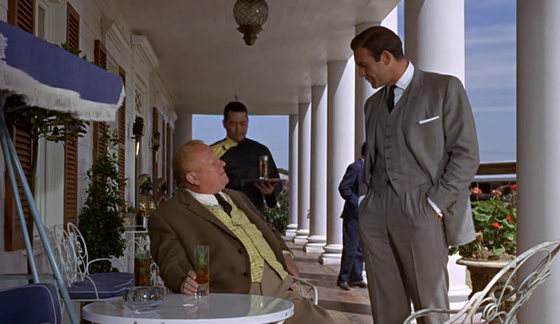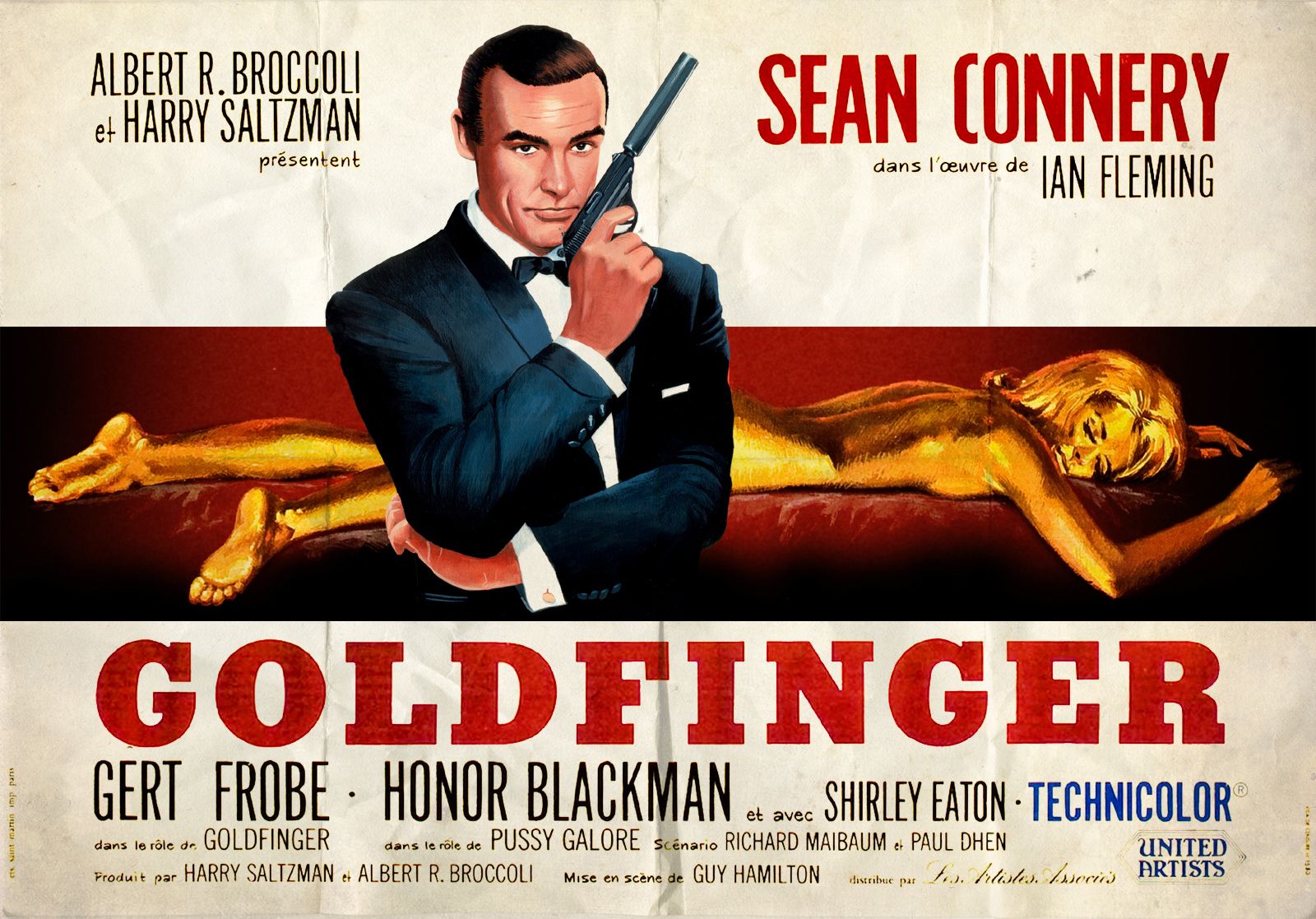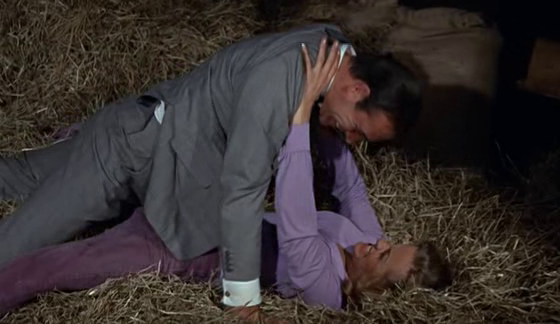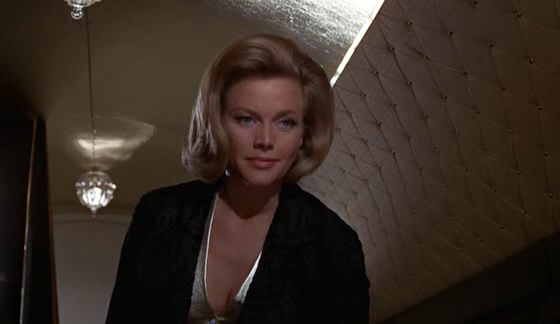In this third outing, the poster proclaims “James Bond is Back in Action” and with Bond facing off against the likes of the nefarious Goldfinger and the sexy femme fatale Pussy Galore we get all that promised action and a whole lot more. It’s with this entry that the series truly came into focus as not only do we get multiple “Bond Girls” but also a plethora of gadgets including the iconic Aston Martin DB5, all of which went towards making this is the quintessential Bond film, one that would set the standards for all subsequent Bond films to follow.
Fans of author Ian Fleming are quite aware that the films often have very little to do with the source but these differences are something that really grew over time, the film adaptation of Dr. No and From Russia with Love may have changed a few things but the plot and characters were left relatively intact, but with the film adaptation of Fleming’s seventh novel Goldfinger we start to see some major changes from the source material. In the book, Auric Goldfinger was the treasurer for SMERSH, the Soviet counterintelligence agency and one of Bond’s chief nemesis, while in the movie Auric is just a man who loves gold so much that he gets in bed with the Chinese in a plot to increase the value of his own holdings. Now, I will give the film credit for improving on the actual criminal plot itself because the one in the book is simply to rob the gold depository at Fort Knox, which is pretty insane, while in the movie the idea is to set off a dirty bomb that would irradiate the gold and thus make Goldfinger's own stockpile worth ten times more than it previously was, and I’ll admit, this was a rather inspired change.
Note: The movie has Bond explain just how impossible the book's plot about robbing Fort Knox was and how ludicrous the idea of driving off with 10,000 tons of gold truly is.
As close as some elements of this movie have to the book it should be pointed that it is with the film Goldfinger that Bond’s relationships with women became even more problematic. As in the book, the movie introduces us to Jill Masterson (Shirley Eaton), a beautiful girl hired by Goldfinger (Gert Fröbe) to help him cheat at cards, but when James Bond (Sean Connery) arrives on the scene he blackmails Goldfinger into losing and then to add insult to injury Bond has a brief sexual fling with the poor doomed girl, and it is here that we begin the long unfortunate trope of women who sleep with Bond ending up dead. Poor Jill is painted gold and left for Bond to find dead in his bed. This does occur in the novel so we can’t blame the filmmakers for this but when Bond later encounters Tilly Masterson (Tania Mallet), who is trailing after Goldfinger to get revenge for her sister’s murder, she is killed off by Goldfinger’s mute henchman Oddjob (Harold Sakata) with nary a thought and it’s kind of off-putting.
Note: The idea that all-over gold paint would suffocate someone is something Ian Fleming totally made up but it does provide for a striking visual.
One certainly can debate whether or not Bond and the Bond films are rife with misogyny – that they are very sexist at times is not up for debate as that is quite apparent in most of the films – but with Goldfinger, we hit new extremes and a lot of that stems from this particular entry having an overabundance of Bond girls. What's a better way to get rid of an unwanted girl than have her knocked off so Bond can freely move onto the next one? But what if the next girl is the head of an all-lesbian organization of cat-burglars? In the film we are introduced to Pussy Galore (Honor Blackman) who is Goldfinger’s personal pilot and the leader of Pussy Galore's Flying Circus – they’re no longer acrobatic cat burglars, as they were in the book, but stunt pilots – who have been hired to help with the plan to irradiate Fort Knox, but wherein the book Pussy Galore is a completely out-of-the-closet lesbian the film barely alludes to this personality trait with the only evidence of her sexuality being when she tells Bond “You can turn off the charm. I’m immune.” Yet despite this claim Bond does manage to win her over, in the worst possible way imaginable.
To say that Bond’s “Raping the gay away” is completely offensive is a vast understatement.
In the documentary Bond Girls Are Forever, Honor Blackman stated that she believed that Pussy Galore only believed she was a lesbian because Goldfinger abused her pretty badly and that Bond's charm got her in touch with her actual heterosexuality, now, I love and respect Honor Blackman but in my opinion, this is a pretty lame explanation for her switching teams, in more ways than one. Her learning that the gas being used was actually lethal, and not knock-out gas as she had been told, should have been enough of a reason for her to turn on her employer with no "Power of Boners" needed. On the plus side of things, Honor Blackman is the oldest actress to ever play Bond's love interest and is only one of two Bond girls to be older than Bond himself, which is certainly a nice change when you consider how absurd the age gap between Bond and his sexual conquests reached in the Roger Moore era.
Honor Blackman, a great femme fatale and one of the best of the Bond girls.
Needless to say, Bond will never be considered a progressive “woke” character but as long as he isn’t championed for that aspect of his character I think we can all get along. What really makes this film work isn’t simply the fact that it is chock full of beautiful women and features Bond up against one of his most iconic villains but because it is with Goldfinger that we are also given an extravaganza of Bond gadgets. Not only is this the first movie to give us a look inside Q Branch, run by the ever-lovable Q (Desmond Llewelyn), but it is here that we are introduced to Bond’s most prized possession, the Aston Martin DB5. Sean Connery may have been the star of this film but this vehicle could be argued as to be worthy of second billing – the Corgi toy was one of my most prized possessions – and with its concealed machine guns, smoke screen emitters and ejector seat it is easily the best of all Bond vehicles.
Sean Connery and his co-star.
Stray Observations:
• As cool as Bond is even he can’t convincingly pull off that “Seagull Hat” we see him wear in the pre-credit sequence.
• It’s with Goldfinger that we get our first pre-credit action sequence that has no bearing on the plot whatsoever.
• Shirley Bassey belting out the lyrics to Goldfinger still gives me chills and it has remained one of my all-time favourite Bond themes.
• With the inclusion of Japanese-American weightlifter and professional wrestler Harold Sakata as Oddjob we get our first true henchman of the Bond franchise.
• Oddjob’s killer derby must have two settings. When we first see it used he decapitates a stone statute with but one throw, yet later when it kills Tilly Masterson it doesn’t even leave a mark let alone decapitate her.
• Not only does Goldfinger give us the first “Death Trap” for Bond to escape from it also provides us with one of the best hero/villain exchanges with James Bond asking “Do you expect me to talk?” which Goldfinger calmly informs our hero “No, Mr. Bond, I expect you to die!”
• Goldfinger gives an elaborate briefing to a group of American gangsters, using elaborate maps and models to explain his plan, but then he kills them all, which begs the question “What was the point of briefing people you then immediately kill?”
Also, I’d love to know where villains go to get their amazing models.
This film also has one of my favourite John Barry scores and I love the way he blended the music from the “Goldfinger” theme with the classic “James Bond Theme” and as mentioned Shirley Bassey’s rendition of the title song is, to put it frankly, pure gold. With the risk of compounding “gold puns” I must say that Goldfinger set the gold standard for Bond films and will most likely forever remain on the "Best of Bond" lists. The previous two films had included such elements as megalomania villains, gorgeous women and stunning locals but it is in Goldfinger that all these things are ratcheted up to eleven, but with the edition of the iconic henchman and Bond’s tricked out Aston Martin this entry raised the franchise to a whole new level, not to mention throwing the entire world in Bondmania, and sure, some elements haven’t dated all that well but overall this is still one of the better Bond films and it cemented Sean Connery as a superstar.







No comments:
Post a Comment